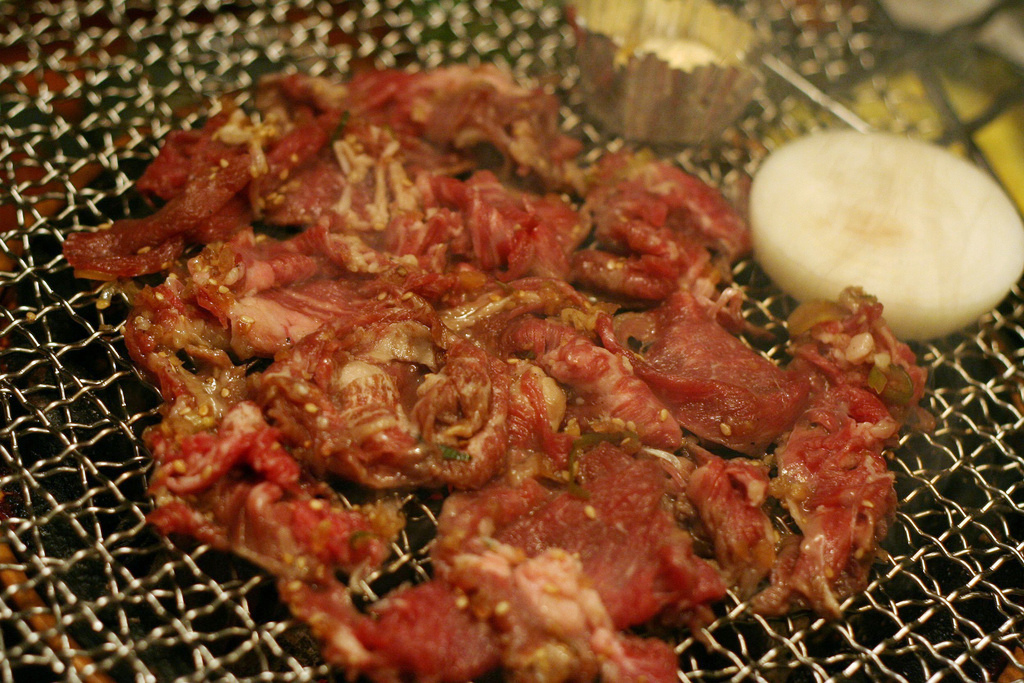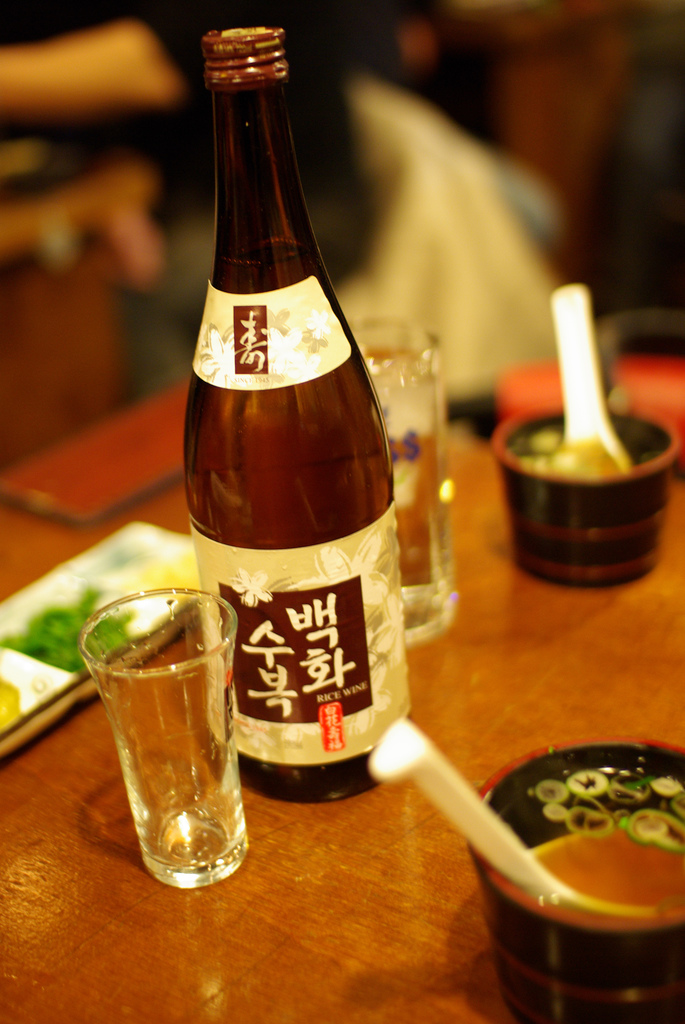|
Anju (food)
''Anju'' () is a Korean term for food consumed with alcohol. It consists of a variety of foods, including both main dishes and side dishes. Consuming food with alcohol is a widespread practice in Korea, especially when the alcoholic beverage '' soju'' is involved. Certain types of foods consumed primarily as ''anju'' include '' golbaengi muchim'', '' nogari'' with peanuts, and '' jokbal''. History Until the Joseon period, alcohol was mainly served in (a type of inn or tavern), where soups with rice, along with traditional alcohol such as , were served to guests. Since the introduction of beer and Western foods into Korea, mainly from Japan in the nineteenth century, bars and pubs have enjoyed a newfound popularity, and many types of Western foods have been consumed as ''anju''. By types of beverage Some foods are considered to be best complemented by certain types of alcohol. For example, '' samgyeopsal'', grilled pork belly, is considered to go best with ''soju'', while ... [...More Info...] [...Related Items...] OR: [Wikipedia] [Google] [Baidu] |
Bulgogi
Bulgogi ( , , ; , ) is a '' gui'' (Korean-style grilled or roasted dish) made of thin, marinated slices of meat, most commonly beef, grilled on a barbecue or on a stove-top griddle. It is also often stir-fried in a pan in home cooking. Sirloin and rib eye are frequently used cuts of beef for the dish. Bulgogi is a very popular dish in South Korea, where it can be found anywhere from upscale restaurants to local supermarkets as pan-ready kits. Etymology came from the Korean word ''bulgogi'' (), consisting of ''bul'' ("fire") and ''gogi'' ("meat"). The compound word is derived from the Pyongan dialect, as the dish itself is a delicacy of Pyongan Province, North Korea. The dish became popular in Seoul and other parts of South Korea, introduced by refugees from Pyongan. It was listed in the 1947 edition of the ''Dictionary of the Korean Language'' as meat grilled directly over a charcoal fire. In the '' Standard Korean Language Dictionary'' published by the National Insti ... [...More Info...] [...Related Items...] OR: [Wikipedia] [Google] [Baidu] |
Nut (food)
A nut is a fruit consisting of a hard or tough nutshell protecting a kernel which is usually edible. In general usage and in a culinary sense, many dry seeds are called nuts. In a botanical context, "nut" implies that the shell does not open to release the seed (Dehiscence (botany), indehiscent). Most seeds come from fruits that naturally free themselves from the shell, but this is not the case in nuts such as hazelnuts, chestnuts, and acorns, which have hard shell walls and originate from a compound ovary. The general and original usage of the term is less restrictive, and many nuts (in the culinary sense), such as almonds, pistachios, and Brazil nuts, are not nuts in a botanical sense. Common usage of the term often refers to any hard-walled, edible kernel as a nut. Nuts are an food energy, energy-dense and nutrient-rich food source. Definition Botany, Botanically, a nut (fruit), nut is a fruit with a woody pericarp developing from a syncarpous gynoecium. True nuts include ... [...More Info...] [...Related Items...] OR: [Wikipedia] [Google] [Baidu] |
Hanu
The Hanwoo (), also Hanu or Korean Native, is a breed of small cattle native to Korea. It was formerly used as a working animal, but is now raised mainly for meat. It is one of four indigenous Korean breeds, the others being the , the and the Jeju Black. History The Hanwoo was traditionally a working animal breed. Until the expansion of the South Korean economy in the 1960s, it was little used for beef production. A herd book was established in 1968. Hanwoo beef has since become a premium product. The Hanwoo was listed by the FAO as "not at risk" in 2007. In 2003, the total population was reported to be about ; in 2014, it was reported as . In 2001, the Hanwoo was suggested to be a hybrid between taurine and indicine cattle. A mitochondrial DNA study in 2010 found it to be closely related to two taurine breeds, the Holstein and the Japanese Black, and distinctly different from the indicine Nelore and . In 2014, single-nucleotide polymorphism analysis found Korean cattle to ... [...More Info...] [...Related Items...] OR: [Wikipedia] [Google] [Baidu] |
Bulgogi
Bulgogi ( , , ; , ) is a '' gui'' (Korean-style grilled or roasted dish) made of thin, marinated slices of meat, most commonly beef, grilled on a barbecue or on a stove-top griddle. It is also often stir-fried in a pan in home cooking. Sirloin and rib eye are frequently used cuts of beef for the dish. Bulgogi is a very popular dish in South Korea, where it can be found anywhere from upscale restaurants to local supermarkets as pan-ready kits. Etymology came from the Korean word ''bulgogi'' (), consisting of ''bul'' ("fire") and ''gogi'' ("meat"). The compound word is derived from the Pyongan dialect, as the dish itself is a delicacy of Pyongan Province, North Korea. The dish became popular in Seoul and other parts of South Korea, introduced by refugees from Pyongan. It was listed in the 1947 edition of the ''Dictionary of the Korean Language'' as meat grilled directly over a charcoal fire. In the '' Standard Korean Language Dictionary'' published by the National Insti ... [...More Info...] [...Related Items...] OR: [Wikipedia] [Google] [Baidu] |
Jeonggwa
''Jeonggwa'' () is a crispy, chewy '' hangwa'' (traditional Korean confection) with vivid colors and a translucent look. It can be made by boiling sliced fruits, roots, or seeds in honey, '' mullyeot'' (rice syrup), or sugar water, then drying the slices, and optionally shaping them into flowers or other decorative forms. The candied fruits, roots, or seeds may have the similar texture to jam, marmalade, or jelly. Types Common ingredients include yuja, quinces, apricots, lotus roots, radishes, carrots, ginseng, balloon flower roots, gingers, burdock roots, bamboo shoots, and winter melons. If water is boiled first with honey (and often with spices such as cinnamon and ginger) and dried fruit is added later, it is called '' sujeonggwa'' (; "water ''jeonggwa''") and served cold as a beverage. Miljeonggwa * ''Aengdu-jeonggwa'' () – candied Korean cherry * ''Boksunga-jeonggwa'' () – candied peach * ''Cheongmae-jeonggwa'' () – candied green Korean plum * ''Cheonmu ... [...More Info...] [...Related Items...] OR: [Wikipedia] [Google] [Baidu] |
Dasik
''Dasik'' () is a bite-size traditional Korean snack food ('' hangwa'') that is normally accompanied by tea. It can be made by kneading grain or other edible seed flour or pollen with honey, then pressing them into a decorative mould called ''dasikpan'' (). A dasik plate usually consists of an assortment of dasik of different colours, including green, yellow, pink, black, and white. Typical ingredients include: rice flour, pine pollen, black sesame, chestnut, and soybean. Varieties *''bam dasik'' () – made of steamed and mashed chestnut, or chestnut powder from finely sliced and sun-dried chestnuts *''geomeunkkae dasik'' () – made of toasted black sesame seed powder *''kkae dasik'' () – made of toasted sesame seed powder *''kong dasik'' () – made of steamed and pounded yellow soybean *''pureunkong dasik'' () – made of steamed and pounded green soybean *''songhwa dasik'' () – made of pine pollen *''ssal dasik'' () – made of steamed, dried, toasted, and then pounded ... [...More Info...] [...Related Items...] OR: [Wikipedia] [Google] [Baidu] |
Bugak
''Bugak'' () is a variety of vegetarian '' twigim'' (deep-fried dish) in Korean cuisine. It is made by deep frying dried vegetables or seaweed coated with ''chapssal-pul'' (; glutinous rice paste) and then drying them again. It is eaten as ''banchan'' (accompaniment to cooked rice) or '' anju'' (accompaniment to alcoholic beverages). Common ingredients are green chili peppers, perilla leaves, perilla inflorescence, camellia leaves, chrysanthemum leaves, burdock leaves, tree of heaven shoots, potatoes, '' gim'' (laver), and '' dasima'' (kelp). Vegetable oils such as perilla oil or soybean oil are typically used for frying. ''Bugak'' is a relatively rare culinary technique in Korean cuisine, along with '' dasima twigak'' (; deep fried vegetables without coating). It is often associated with Korean temple cuisine. Varieties * ''dangeun-bugak'' () – made with carrots * ''dasima-bugak'' () – made with kelp * ''deulkkae-songi-bugak'' () – made with perilla inflorescence ... [...More Info...] [...Related Items...] OR: [Wikipedia] [Google] [Baidu] |
Cheongju (beverage)
''Cheongju'' (), sometimes romanized as ''Chungju'', is a clear, refined rice wine of Korean origin. Names The word ''cheongju'' () consists of two characters: ''cheong'' () meaning "clear" and ''ju'' () meaning "alcoholic drink". It contrasts with ''takju'' (), as "tak" () means "turbid". The word ''takju'' usually refers to ''makgeolli'' (milky, unrefined rice wine). The hanja characters 淸酒 are the same as the kanji pronounced ''seishu'' used on the labels of sake. The native Korean word for "clear wine", ''malgeun-sul'' (), is also used to refer to ''cheongju''. Another name for ''cheongju'' is ''yakju'' (), which literally translates into "medicinal wine". History According to '' Things on Korea''—a 12th-century book on Korea written by Song Chinese scholar Sun Mu (孫穆)—the Goryeo people used non-glutinous rice to brew rice wine. Another 12th-century Chinese book, '' Illustrated Account of Goryeo'', reports that Korean rice wine that is made with '' nuruk'' ... [...More Info...] [...Related Items...] OR: [Wikipedia] [Google] [Baidu] |
Sausage
A sausage is a type of meat product usually made from ground meat—often pork, beef, or poultry—along with salt, spices and other flavourings. Other ingredients, such as grains or breadcrumbs, may be included as fillers or extenders. When used as an uncountable noun, the word ''sausage'' can refer to the loose sausage meat, which can be used loose, formed into patties, or stuffed into a casing. When referred to as "a sausage", the product is usually cylindrical and enclosed in a casing. Typically, a sausage is formed in a casing traditionally made from intestine, but sometimes from synthetic materials. Sausages that are sold raw are cooked in many ways, including pan-frying, broiling and barbecuing. Some sausages are cooked during processing, and the casing may then be removed. Sausage making is a traditional food preservation technique. Sausages may be preserved by curing, drying (often in association with fermentation or culturing, which can contribute to pres ... [...More Info...] [...Related Items...] OR: [Wikipedia] [Google] [Baidu] |
Twigim
A fritter is a portion of meat, seafood, fruit, vegetables, or other ingredients which have been battered or breaded, or just a portion of dough without further ingredients, that is deep-fried. Fritters are prepared in both sweet and savory varieties. Definition The 1854 edition of ''An American Dictionary of the English Language'' by Noah Webster defines fritter as a transitive verb meaning "to cut meat into small pieces to be fried". Another definition from 1861 is given as "a pancake cont. chopped fruit, poultry, fish; also a small piece of meat fried". Varieties Africa West African countries have many variations similar to fritters. The most common process includes the blending of peeled black-eyed pea The black-eyed pea or black-eyed bean is a legume grown around the world for its medium-sized, edible bean. It is a subspecies of the cowpea, an Old World plant domesticated in Africa, and is sometimes simply called a cowpea. The common commerci ...s with peppers an ... [...More Info...] [...Related Items...] OR: [Wikipedia] [Google] [Baidu] |
Pizza
Pizza is an Italian cuisine, Italian, specifically Neapolitan cuisine, Neapolitan, dish typically consisting of a flat base of Leavening agent, leavened wheat-based dough topped with tomato, cheese, and other ingredients, baked at a high temperature, traditionally in a wood-fired oven. The term ''pizza'' was first recorded in 997AD, in a Latin manuscript from the Southern Italy, southern Italian town of Gaeta, in Lazio, on the border with Campania. Raffaele Esposito is often credited for creating the modern pizza in Naples.Arthur Schwartz, ''Naples at Table: Cooking in Campania'' (1998), p. 68. .John Dickie, ''Delizia!: The Epic History of the Italians and Their Food'' (2008), p. 186.Father Giuseppe Orsini, Joseph E. Orsini, ''Italian Baking Secrets'' (2007), p. 99. In 2009, Neapolitan pizza was registered with the European Union as a traditional speciality guaranteed (TSG) dish. In 2017, the art of making Neapolitan pizza was included on UNESCO's list of intangible cultura ... [...More Info...] [...Related Items...] OR: [Wikipedia] [Google] [Baidu] |
Korean Fried Chicken
Korean fried chicken, in Korean ''chikin'' (, from the English word "chicken"), refers to a variety of fried chicken dishes created in South Korea. These include the basic ''huraideu-chicken'' (, from the English words 'fried chicken') and the spicy '' yangnyeom chicken'' (, 'seasoned chicken'). In South Korea, fried chicken is consumed as a meal, an appetizer, ''anju'' (food that is served and eaten with drinks), or as an after-meal snack. Korean fried chicken was described by Julia Moskin of ''The New York Times'' as having a "thin, crackly and almost transparent crust". The chicken is usually seasoned with spices, sugar, and salt, before and after being fried. Korean fried chicken restaurants commonly use small or medium-sized chickens; these younger chickens result in more tender meat. After frying, the chicken is usually hand-painted with sauce using a brush to evenly coat the chicken with a thin layer. Pickled radishes and beer (or carbonated drink) are often served with ... [...More Info...] [...Related Items...] OR: [Wikipedia] [Google] [Baidu] |






